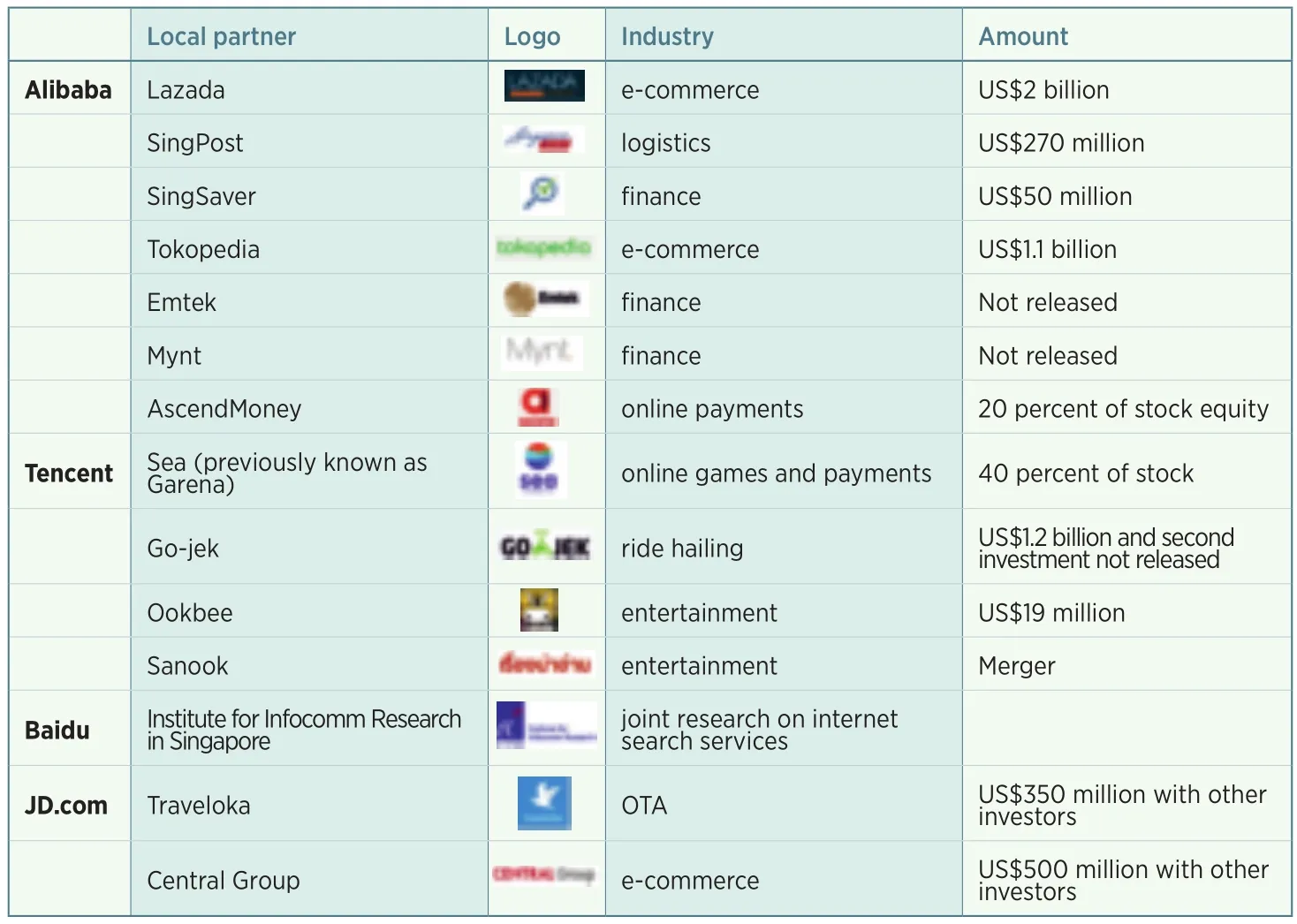WEAVING THE WEB
2018-11-05ByHouWeili
By Hou Weili
Chinese tech firms bring technology, investment and business models to boost startups and e-commerce in ASEAN countries
In early August, a new shopping experience created by Chinese e-commerce giant JD.com mesmerized Jakarta, capital of Indonesia. Partially-automated without cashiers or checkout counters, the unstaffed store allows customers to finish a purchase with simple steps, scanning with the phone, grabbing whatever they like and walking away. The store charges users’ online payment account.
The store is called JD.ID X-Mart.The new Jakarta store is larger than the existing 20 located in China and marks the online retailer’s first attempt to deliver its automated store technology overseas. The 270-squaremeter retail space offers a wide variety of products ranging from fashion and apparel to fast-moving consumer goods and beauty products.
From home to abroad, JD.ID X-Mart represents a complete set of technological solutions for unstaffed stores and is fostering a new replicable commercial model to expand online retail to offiine space and rede fine the shopping experience.“We are committed to making daily life easier and better by connecting consumers to suppliers around the world and lowering the social cost through our technology-driven ful fillment system,” declared Liu Qiangdong, Chief Executive Officer of JD.com.
Liu’s aspiration mirrors Chinese tech efforts to expand technologies and business models to boost startups and businesses closely related to daily life in ASEAN countries. From interest to investment, they are working with local startups to jointly build a regional ecosystem for the internet economy.
Tantalizing Market
Southeast Asia, especially ASEAN countries, has long been an area of interest for businesses around the world as they look for destinations for global expansion. A 2016 report by leading global real estate consultancy firm Cushman & Wake field showed that Singapore is the Asian country most favored by multinational companies, with 4,200 transnational enterprises setting up regional headquarters on the island, making it a stronghold to leverage the Asian market.
According to ASEAN Statistics Yearbook in 2017, the average annual GDP growth rate in ASEAN countries was 5.1 percent from 2010 to 2016.The International Monetary Fund forecast the annual GDP growth rate in ASEAN to remain at 5 percent from 2016 to 2021. “The booming economy,the rising affiuence of consumers and the proliferation of smart phones are all good news for sectors of consumables and e-commerce,”noted Yu Hong, Vice President of GGV Capital, a venture capital firm with operations in the United States and Asia.
A recent report compiled by Google and Singapore-based investment firm Temasek showed that Southeast Asia has 330 million internet users with 3.5 million more going online each month. Netizens in the region outnumber the entire population of the United States. The market value of internet economy is expected to increase to US$200 billion in 2025,which will be 6 percent of the region’s total GDP.
The report counted total e-commerce sales in Southeast Asia at US$10.9 billion, a surge of 41 percent year on year. Notably, internet users in the region are mainly on mobile,with most skipping the PC altogether and going straight to phones and tablets.
Increasing Presence
Considering the attractive market potential, many global tech firms have attempted to increase their presence in Southeast Asia,including those from China. The Chinese tech firms operating in the region have performed impressively in the domestic market and have incentive to going global after four decades of reform and opening up.Alongside encouraging technological innovations from the national level,China has introduced a host of policies to support the commercialization of research achievements including the Internet Plus initiative and the big data strategy.
Thanks to such efforts, China’s digital economy, valued 26 trillion yuan (US$3.8 trillion) in 2017,accounts for 32 percent of the national GDP according to the China Academy of Information and Communications Technology. The market now is dominated by the three giants Baidu,Alibaba and Tencent (BAT), which have all expanded from startups focused on segmented market to a conglomerates offering a diversi fied range of online products and services.


Chinese Internet Giants in ASEAN
In addition to exponential expansion in scale, these internet giants are now leading technological innovation and becoming dominant driving forces in the commercialization of research, as demonstrated by the JD.ID X-Mart.“Like businesses from Silicon Valley decades ago, they are attracting followers from foreign countries,especially those from the neighboring Southeast Asia where the cultures and customs are similar,” said Yu. For example, the business model of bike sharing originated in China, but is now popular in the region.
In fact, tech startups are active in Southeast Asia and serving as prominent forces engaging in online retailing, ride hailing, food delivery,online gaming and content providing among other realms. Regional players include e-commerce firms like Lazada,Shopee and Tokopedia and ride hailing platforms Grab and Go-jek.
In April 2016, Alibaba took the first step among Chinese firms to gain a foothold in the nascent market with an investment of US$1 billion in Lazada, a Singapore-based e-commerce platform founded in 2012 with about 23 million monthly active users. The deal enabled Alibaba to expand to Indonesia,Thailand, Malaysia, the Philippines and Vietnam. One year later, Alibaba firmed up its share of the company,increasing ownership to 83 percent with another US$1 billion.
However, Alibaba’s domestic rivals are also on the move. Tencent has long-standing partnerships with Thailand tech companies such as web portal Sanook. The most prominent is a 2017 US$1.2 billion investment in Go-jek, a motorbike on-demand startup battling Grab in Indonesia.JD.com started even earlier by establishing ful fillment centers in Indonesia as early as in 2015.
“Compared to Amazon and Uber,Chinese tech firms are latecomers to Southeast Asia, but they brought know-how and capital that drove explosive growth in the domestic market, which makes them acutely adaptable to local situations,”illustrated Yu.
Improving the Economic Ecosystem
Lazada CEO Max Bittner has noted that the alliance with Alibaba enables it to expand its available services and fall back on Alibaba when needed. Gojek also developed a mobile payment business called Go-Pay that facilitates online experiences such as shopping,messaging and on-demand services.
Indeed, the technological infusion goes far beyond investment as Chinese tech firms are also working to improve the infrastructure for the internet economy. To empower Lazada’s expansion, programmers from Alibaba assisted in upgrading the retailing platform with innovative know-how. Before that, vendors had to call the platform and be guided by customer service staff to finish opening an online shop, which usually took days.
In just half a year with Alibaba’s assistance, Lazada developed a new platform enabling self-service registration and management of the product catalogue of online stores. As a result, 135,000 new vendors joined the platform the next year, increasing available products and services sevenfold.
Alibaba is also committed to solving long-standing conundrums on the buyers’ side like improving the online payment and ful fillment systems.
The company also fuels local national strategies of boosting digital economies. In July 2017, Alibaba joined a local partner to build the Digital Hub in Malaysia, an incubator for tech startups that provides access to everything needed to run a business from workspace to risk capital investors, startup mentors and cluster of tech industries.
“The moves align with the principles and the Belt and Road Initiative of building connectivity for win-win cooperation as they break trade barriers and create opportunities for small businesses,” beamed Zhang Yong, CEO of Alibaba Group. As China pledges to open its door wider, he sees more opportunities for partnerships with neighboring ASEAN countries in the near future.
